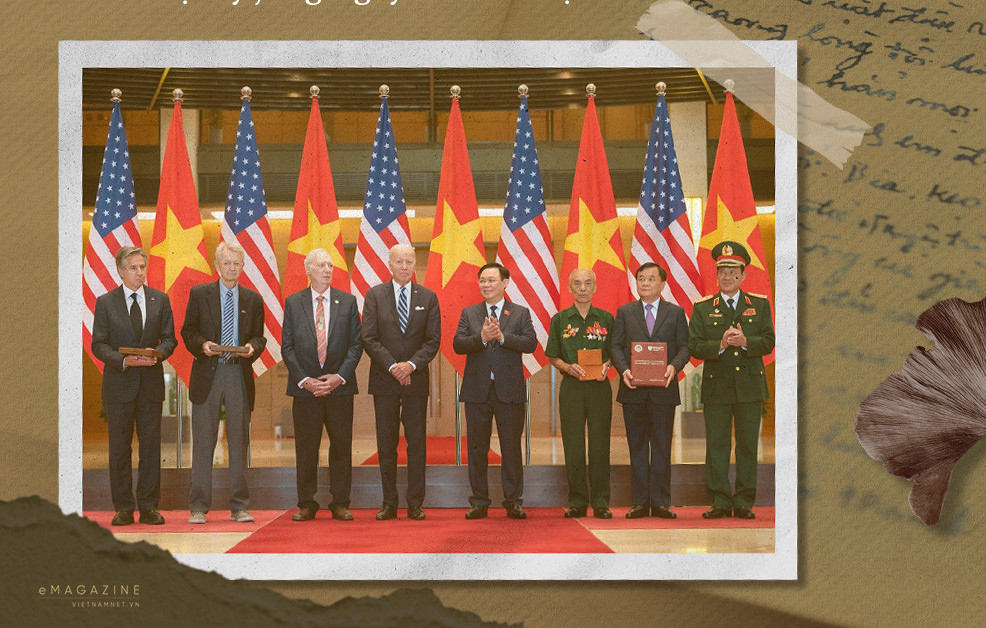
But a miracle later occurred: on the day the US President Joe Biden visited Vietnam, Thien received the diary about his youth witnessed by the leaders of Vietnam and the US.
Several days afterwards when VietNamNet reporters visited him at his home, a small house in Cau Giay district in Hanoi, Thien said he was still filled with emotion about the diary he wrote at the age of 17 while fighting on the southern battlefield.
On April 15, 1965, Thien officially joined the army. In addition to simple clothes, he brought a handkerchief, a notebook and a pen, given to him as presents by his friends.
The young man from the lowlands took a training course and spent several months walking from the north to the central and southern regions.
In October 1965, Thien began writing in his diary. Every soldier, when going to battlefield, needed to prepare his mind for any situation, including the chance that he would never return. So he decided to write in his notebook about the days of fighting and the events in his life.
To keep it secret, he used simple words and briefly described the events he witnessed, without mentioning the names of places and detailed events.
The diary, comprising 145 pages, recorded his feelings about the journey to the south when he went through the provinces of Hoa Binh, Ha Dong, Thanh Hoa, Nghe An, Ha Tinh, Quang Tri and Kon Tum, where his last words were written down.
In 1967, he lost his diary during a raid in Suoi Day commune that the US called Junction City. The diary was picked up by an American soldier and brought to the US.
Thien wrote about the fierce battles and his comrades. One of them was the platoon leader, who joined the army on the same day as Thien and survived the bullets together.
One day, during a mission in Kon Tum, he contracted malaria and passed away.
The death of the friend, whom he treated as a close relative, left him desolate. Forgetting about the principle of secrecy, he wrote in the diary about the death and the feeling when he heard about the bad news.
“February 19, or the 24th day of the first lunar month. The most painful day: a brother and a comrade of mine died on the way to implement his mission - Nguyen Van Xuan - Dong Quach village, Nam Ha commune, Tien Hai district, Thai Binh province."
This information about the comrade later helped the research team at Harvard University find Thien after the war.
The research team said there was no information about the owner or service unit of the Vietnamese Army in the battlefield documents stored at the Captured Document Exploitation Center (CDEC).
To track down the author of the diary, the research team went to the hometown of the revolutionary martyr Nguyen Van Xuan, who was mentioned in the diary. The team members met Xuan’s daughter who showed them how to find veteran Nguyen Van Thien.
In general, the documents collected on battlefields, like this diary, are handwritten and are not intact. They are damaged because of harsh weather conditions or fire, and because they have gone through many hands.
In addition, diaries were written with dialects of three regions, which made it difficult for specialists from Harvard University to find the authors. They tried every possible means, including applied linguistics, military history and information from interviews, to implement the mission.
On September 11, an officer from the Ministry of Foreign Affairs (MOFA) invited Thien to the National Assembly House. About two hours before the meeting, he was told that he would get back his diary.
Thien was moved when receiving the diary and giving souvenirs to two American veterans, Matt Keenan and Chuck Searcy from Veterans for Peace, with the witness of Vietnamese National Assembly chair Vuong Dinh Hue and US President Joe Biden.
In the main hall of the Vietnamese National Assembly building, the veterans from the two former enemy countries hugged each other like old friends reuniting after many years.
Tran Thuong